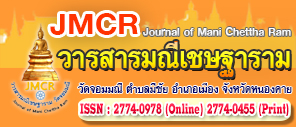THE TRAINING VALUE OF ANHUI HUAGUDENG DANCE
คำสำคัญ:
Anhui Huagudeng Dance,, Training Value,, Dance Performance.บทคัดย่อ
The traditional training methods for Anhui Huagudeng dance have notable issues that hinder its effectiveness. Specifically, male and female dancers are trained separately in art colleges in China, which is problematic. This separation fails to support the emotional expression and interpersonal dynamics required for effective performances, especially in duet (pas de deux) and group dances. Moreover, the current teaching practices do not fully leverage the potential of the dance's movements in developing essential skills such as control over the waist, legs, and feet. Addressing these challenges is vital to enhancing the dancers' abilities to embody the emotional and technical nuances of Anhui Huagudeng dance.
This study aims to analyze the training value of Anhui Huagudeng dance, focusing on the skills it cultivates and its contribution to emotional expression. Using literature research and participatory observation methods, the research found that the dance significantly improves the dancers' control over their waist, legs, and feet. Additionally, its movements, rooted in the expression of love and emotion, require male and female dancers to train together to foster mutual adaptation and emotional communication. Furthermore, the study highlights the importance of duet performances in honing these skills, making integrated training sessions essential for achieving high-quality performances.
The findings underscore the training value of Anhui Huagudeng dance in both solo and group formats. Its unique movement techniques and emphasis on emotional expression are invaluable for developing dancers' physical and expressive capabilities, suggesting the need for revised teaching practices to optimize its impact.
References
Cao Ning. (2009). Dance Appreciation. Nanning: Guangxi Normal University Press.
Han Yongdao. (1998). Annals of Fengtai County. Huangshan: Huangshan Book House press.
Li Yan. (2009). The training value of Gujiazi in Anhui Huagudeng's teaching. Liaoning: Liaoning Higher Vocational Technical Institute Journal.
Li Yan. (2009). Taking "shanshenbu" as an example, the significance of foot training in Anhui Huagdueng is discussed. Wuhan: Drama house.
Ning, Q., Maneewattana, C., & Liu, L. (2024). Analysis of Intangible Cultural Heritage Inheritance and Influencing Factors from the Perspective of Social Change: A Case Study of'the Zhuang Ethnic Eight Immortals Wind and Percussion Music'in Northwest Guangxi, China. Journal of Dhamma for Life, 30(2), 431-448.
Sun Chao. (2017). The origin of Anhui Huagudeng. Beijing: Modern music journals.
Wu Douzhen. (1995). Annals of Yingshang County. Huangshan: Huangshan Book
House press.
Wang Yanzhang. (2019). On the training value of Anhui Huagudeng, a folk dance of Han nationality. Wuhan: Drama house.
Zhiqin Yi. (1990). Annals of Huaiyuan County. Shanghai: Shanghai Academy of Social Sciences Press.


